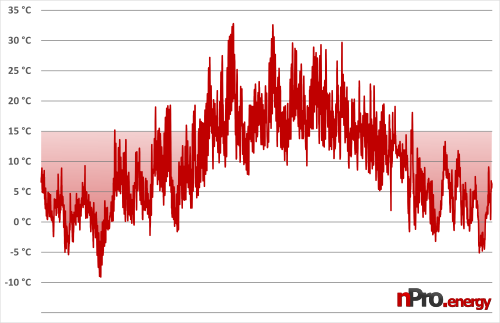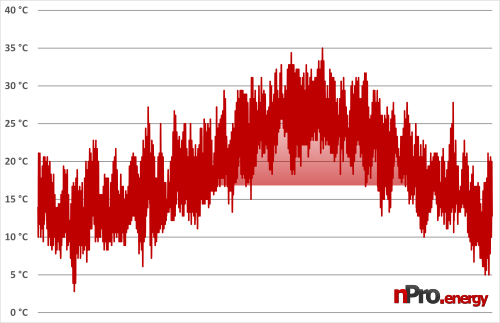Degree days for heat load calculation
Degree days play an important role in energy evaluation and heating load calculation. On this page, you find a short introduction to the topic of degree day numbers.
What are degree days?
Degree day numbers are a measure to quantify the heating or cooling demand of a building. They are calculated based on measurements of the outside air temperature. Degree day numbers are approximately linearly related to the demand needed to heat or cool a building. Degree day numbers are also used for weather adjustment or to estimate the annual heating or cooling demand of a building.
Heating degree days
Heating degree days are determined relative to a heating limit temperature and an indoor temperature. The heating limit temperature describes the minimum outdoor air temperature at which the building does not require heating energy to maintain the indoor temperature. The number of heating degree days is the sum of all temperature differences between the daily mean temperature of the outside air and the indoor temperature for all days when the daily mean temperature of the outside air is below the heating limit temperature (HLT). This can be expressed as follows: $$HDD = \sum_{i=1}^{365} T_{inner} - \bar{T}_{i,air},~\mathrm{if}~\bar{T}_{i,air} < T_{HLT}$$ Graphically, the calculation of heating degree days is shown in Figure 1. The heating degree days correspond to the area between the air temperature profile and the heating limit temperature (here 15 °C).

| Country/region | Heating limit temperature |
|---|---|
| European Union | 15.5 °C |
| Denmark | 17 °C |
| Finland | 17 °C |
| Switzerland | 12 °C |
| USA | 18.3 °C |
When calculating degree day numbers, the heating limit temperature and the set temperature are the decisive parameters. While the indoor temperature can often be estimated to 20 °C, the heating limit temperature is more difficult to determine. Guidelines for the selection of the heating limit temperature are often defined in standards (compare Table 1). However, the heating limit temperature is not the same for all buildings and depends in particular on the individual building use and the insulation standard. The difference between the heating limit temperature and the indoor temperature is a measure of the heat input due to internal heat gains in the building and solar radiation. If these two effects were not present, the heating limit temperature would be identical to the indoor temperature. Particularly high internal heat gains, for example in a busy office with high waste heat flows from technical equipment (computers, lighting), result in a lower heating limit temperature. Strictly speaking, the heating limit temperature also varies over time, depending on the current internal heat gains and solar irradiation conditions.
Cooling degree days
Just as heating degree days make a statement about the heating demands of a building, cooling degree days allow statements about the cooling demands of a building. Here, the cooling limit temperature describes the maximum outside air temperature at which a building requires no cooling energy to maintain the room temperature. Analogous to the heating degree days, the number of cooling degree days describes the sum of the temperature differences between the daily mean temperature of the outside air and the indoor temperature for all days when the daily mean temperature of the outside air is above the cooling limit temperature. In terms of the formula, this is expressed as follows: $$CDD = \sum_{i=1}^{365} \bar{T}_{i,air} - T_{inner},~\mathrm{if}~\bar{T}_{i,air} > T_{CLT}$$ For Almería (Spain), the calculation of the cooling degree days is graphically shown in Figure 1. The cooling degree days correspond to the area between the air temperature profile and the cooling limit temperature (here 17 °C).

Sources
- Spinoni J., Vogt J., Barbosa P. 2015: European degree-day climatologies and trends for the period 1951–2011. In: International Journal of Climatology 35 (1): 25–36. DOI: 10.1002/joc.3959.
- VDI 2067
- VDI 3807
nPro software
Plan your energy system with nPro!

 English
English
 Deutsch
Deutsch


